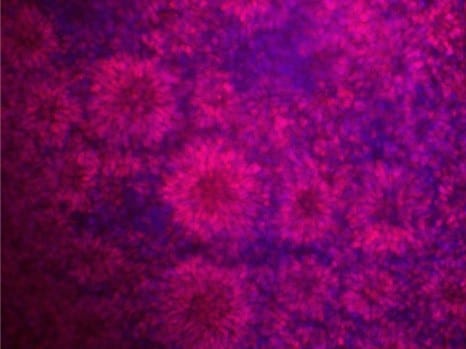
Scientists have devised a technique to sort out which heart cells can replicate and which cannot, a critical step toward treatments that may one day help the heart heal itself after injury.
The method, published in the journal Circulation Research, removes a significant roadblock to developing ways to regrow healthy cardiac muscle tissue, a feat not currently possible.
“This new technique solves a longstanding problem that for years has stymied our ability to develop regenerative treatments for the heart,” said Stefan Jovinge, M.D., Ph.D., the study’s senior author and director of the DeVos Cardiovascular Research Program at Van Andel Institute and Spectrum Health. “It’s a major step forward that we aim to translate into improved patient care.”
For decades, scientists have searched for ways to harness the heart’s regenerative potential to fix damage related to heart attack and heart failure, but their attempts have been largely unsuccessful.
Unlike the skin or bones, which readily heal by stitching together wounds or breaks with new, healthy cells, heart muscle cells largely lose their ability to replicate early in life (instead, they progress through the cell cycle but, in most cases, they do not actually divide). This leaves patients and physicians with only a few surgical options to mitigate further damage and just one option to totally repair the problem should the damage be too severe: a heart transplant.
The new method combines two technologies — molecular beacon technology and fluorescence activated cell-sorting — to specifically isolate cells that successfully divide. This will allow scientists to determine the mechanisms underlying heart muscle cells’ regenerative potential, which is critical to the development of regenerative strategies aimed to cure patients with heart injury.
“Now that we can accurately identify these cells, we can start to determine the mechanisms that allow them to divide and develop ways to jump-start this process,” Jovinge said. “This work is an excellent example of how basic research can have a major impact on future clinical care.”
The findings build on previous research by Jovinge’s team that showed, contrary to long-held beliefs, some cells in the heart are indeed capable of replicating. This discovery was hailed as a “notable advance of 2015” by Nature Medicine, one of the world’s top medical research journals.
Learn more: New technique lays foundation for regenerative cardiac therapies
The Latest on: Regenerative cardiac therapies
[google_news title=”” keyword=”regenerative cardiac therapies” num_posts=”10″ blurb_length=”0″ show_thumb=”left”]
via Google News
The Latest on: Regenerative cardiac therapies
- Simulating heart disease in a 3D modelon May 2, 2024 at 2:15 am
In doing so, she not only creates valuable platforms for research into heart disease, but also the basis for new forms of therapy ... regenerative potential of human ventricular progenitor (HVP) cells ...
- Preclinical study finds novel stem cell therapy boosts neural repair after cardiac arreston May 1, 2024 at 10:13 am
Researchers at the University of Maryland School of Medicine (UMSOM) have identified an innovation in stem cell therapy to regenerate neural cells in the brain after cardiac arrest in an animal model.
- Invest In A Revolutionary Gene Therapy With CRISPR Therapeuticson April 30, 2024 at 10:25 am
CRISPR Therapeutics' Casgevy could generate significant shareholder value if proven to be successful. Learn why I am highly bullish on CRSP stock.
- Japanese researchers test cardiac spheroids for heart regeneration in monkeyson April 26, 2024 at 9:33 pm
Regenerative heart therapies involve transplanting cardiac muscle cells into damaged areas of the heart to recover lost function.
- Capricor Therapeutics Announces Positive Type-B Meeting with FDA for CAP-1002 Program for Duchenne Muscular Dystrophyon April 24, 2024 at 8:00 am
Company Aligned with FDA on Demonstration of Non-Clinical Comparability; Allowing for Immediate Use of San Diego Manufacturing Facility--FDA ...
- 3D Cell Culture Market is expected to reach revenue of USD 5.0 Bn by 2032, at 12.0% CAGR: Insights by Dimension Market Researchon April 23, 2024 at 8:25 am
Exploring the Dynamics of the 3D Cell Culture Market by an In-Depth Analysis of Growth Trajectories, Key Players, and Future TrendsNew Jersey, New York, Los Angeles, Austin, San Diego, Philadelphia, ...
- 5 Cell and Gene Therapy Decisions to Watch in 2024on April 21, 2024 at 9:03 pm
All signs point to 2024 surpassing 2023 as a landmark year for cell and gene therapy,” David Barrett, CEO of the American Society of Gene & Cell Therapy (ASGCT), told BioSpace. The first approval this ...
- Secrets of zebrafish heart regeneration could transform human cardiac careon April 20, 2024 at 12:30 pm
Zebrafish heart tissue regeneration is a captivating prospect for transformative advances in human cardiac care ...
- Longeveron Raises a Total of $11.4 Million in Gross Proceeds from Warrant Exercise Offering and Public Offeringon April 18, 2024 at 1:05 pm
Inc. (NASDAQ: LGVN) (“Longeveron” or the “Company”), a clinical stage biotechnology company developing cellular therapies for life-threatening and chronic aging-related conditions such as hypoplastic ...
- Kansas Regenerative Medicine Center celebrates 10 years of transformative healthcareon April 18, 2024 at 11:29 am
Milestone achieved by Kansas Regenerative Medicine Center as the organizations marks 10 years of helping patients.
via Bing News










